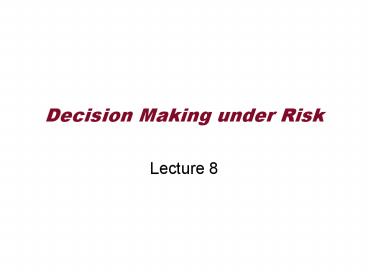Decision Making under Risk - PowerPoint PPT Presentation
1 / 17
Title:
Decision Making under Risk
Description:
... more possible events (state of worlds) over which the individual has no direct control. ... of winning or losing, you don't know if you are going to win or lose! ... – PowerPoint PPT presentation
Number of Views:64
Avg rating:3.0/5.0
Title: Decision Making under Risk
1
Decision Making under Risk
- Lecture 8
2
Todays Topics
- Difference between risky and uncertain situations
- Alternative theories of decision making (using
survey results) - Maximizing Expected Wealth
- Risk to Return tradeoff
- Maximizing Expected Utility
- Algebra of Expectations (and Geometry)
3
Risk versus Uncertainty
- Let us assume that the individual may experience
two or more possible events (state of worlds)
over which the individual has no direct control. - If the individual knows or can assign
probabilities to each of these possible events
then the individual is said to face a risky
situation. - If the individual cant assign probabilities to
these events then the individual is said to be
making decision under uncertainty.
4
Decision to Gamble
WIN WealthWoAW
p
Accept Gamble
(1-p)
LOSE WealthWo-AL
Reject Gamble
WealthWo
5
Gambles
- Risky situations are often referred to as a
gamble -- while you know what you win or lose
as well as the probabilities of winning or
losing, you dont know if you are going to win or
lose! In general, a gamble can be characterized
as - Event Probability Amount
- Winning p AW
- Losing (1-p) - AL
- Expected Winnings
- EG p AW (1-p)(-AL)
- Variance
- VG p(1-p) (AW-AL)2
6
Alternative Forms of Gambles
- Often we think of gambling in slightly a
different manner. In order to gamble, you have
put up L dollars. If you win then you walk away
with W dollars. Your net winnings (Aw) are W-L
dollars. If you lose then you walk away with
nothing but you have lost the L dollars you
wagered to play the game. Consequently, your
expected gain from playing the game - p (W-L) (1-p) (-L) p W - L
- Should how we state the game affect the decision
of an individual to either accept or reject the
gamble?
7
Should how the gamble is stated affect behavior?
- Gamble 1 I flip a fair coin and I will pay
you 1,000 if it comes up heads and you will pay
me 500 if it comes up tails. - Gamble 2 I will put 1,000 on the table and you
will put 500. We will flip a fair coin and if
it comes up heads you take what is on the table
otherwise (tails) I will take what is on the
table.
8
Hypothesis of Maximizing Expected Income or
Wealth
- How will individuals choose between accepting the
gamble or rejecting it? - Hypothesis 1 Individuals will only accept the
gamble if it is expected to increase their
expected wealth or income -- in other words if
the gamble has a positive expected winnings - Accept if EG PAW -(1-P)AL gt 0
- Reject if EG PAW -(1-P)AL lt 0
- Note
- EIncome P(MAW) (1-P)(M- AL) M (PAW
-(1-P) AL) M EG
9
2nd Hypothesis -- Tradeoff between risk and reward
Return
Risk
10
Third Hypothesis
- The individual will accept the gamble only if the
expected utility of the gamble exceeds the
utility they would enjoy if they rejected it.
Let us assume that the individual has M dollars
of income. Instead of focusing upon the dollar
values of winnings and losses, let us formulate
the utility of the gamble where U(X) is the
utility of having X with certainty - Event Probability Net Income
- Winning p MAW
- Losing (1-p) M-AL
- Expected Utility
- EUGamble p U(MAW) (1-p) U(M-AL)
11
Maintained Hypothesis
- The hypothesis we will pursue when considering
decision making under risk is often called the
von Neumann-Morgenstern hypothesis that
individual facing risk will choose the option
that maximizes their expected utility.
12
Graph of Expected Utility
U
UW U(MAW)
E(Ugamble)
U(M)
UL U(M-AL)
Income
13
Risk Aversion
- Notice in the last graph, if the E(G) 0 then
- U(M) gt E(Ugamble)
- Reject a fair bet.
- Are there individuals would like to gamble? Or
would be indifferent?
14
Risk Averse (E(G)0)
U
UW U(MAW)
U(M)
E(Ugamble)
UL U(M-AL)
Income
15
Risk Lovers (E(G)0)
U
UW U(MAW)
E(Ugamble)
U(M)
UL U(M-AL)
Income
16
Risk Neutral (E(G)0)
U
UW U(MAW)
E(Ugamble)
U(M)
UL U(M-AL)
Income
17
For Next Lecture
- Chapter 6 pages 187 to 193 and Appendix
- Topic Insurance and Search Behavior (if time
permits)































